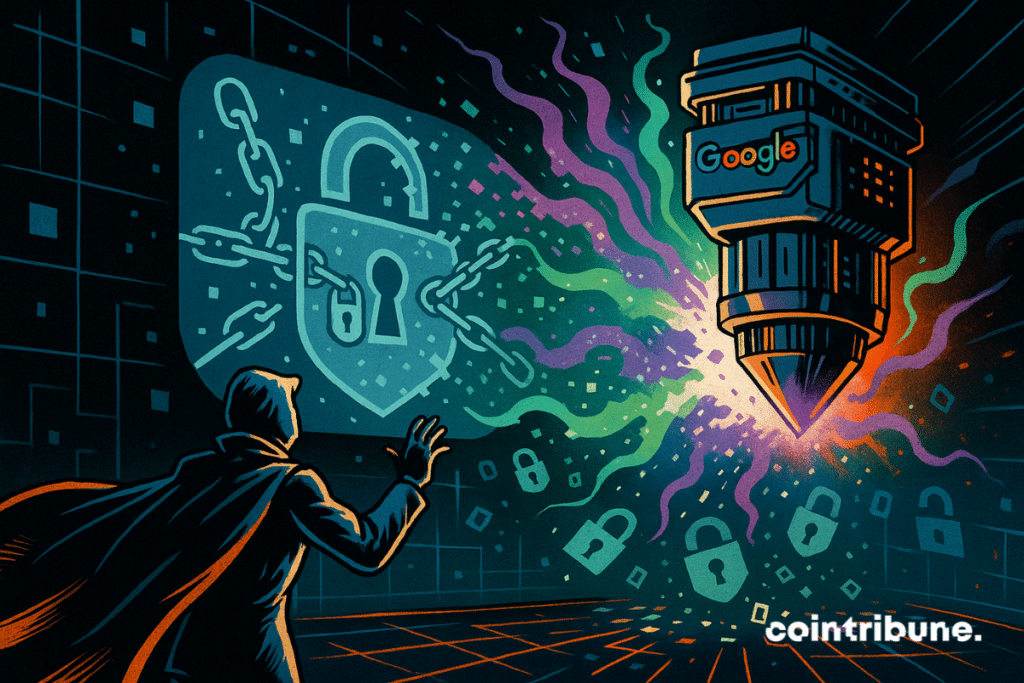Google Showcases Verifiable Quantum Advantage
Google claims to have reached a major milestone in quantum computing. Its Willow processor reportedly performed a molecular modeling task 13,000 times faster than a supercomputer. The announcement, supported by verifiable results, reignites the debate on the security of cryptographic systems. As bitcoin and other protocols rely on algorithms vulnerable to quantum computing, this technical breakthrough turns a theoretical threat into a concrete challenge for the entire blockchain ecosystem.

In brief
- Google has unveiled a major breakthrough in quantum computing with its Willow processor, capable of modeling a molecule 13,000 times faster than a supercomputer.
- The experiment relies on the “quantum echoes” technique, an imaging method that leverages the properties of qubits.
- This performance marks the first verifiable “quantum advantage,” with results reproducible on similar machines.
- While this advance does not yet threaten cryptocurrencies, it reignites concerns over the vulnerabilities of current cryptographic algorithms.
Google crosses a milestone with Willow, its quantum processor
Google announced it had reached a historic milestone in the race for quantum computing, as this threat slowly approaches bitcoin. Its Willow processor enabled mapping the characteristics of a molecule 13,000 times faster than a state-of-the-art supercomputer.
A performance that, according to the tech giant, marks the very first “verifiable quantum advantage”. The experiment, conducted using the “quantum echoes” technique, involved targeting a qubit with a precise signal, then measuring the resulting return signal, enabling ultra-detailed imaging.
“We have demonstrated that this type of experiment can be reproduced on any system with equivalent technical specifications,” explained Google’s research team, emphasizing the scientific robustness of their approach.
This advancement goes beyond a one-time performance, marking a pivotal step in the credibility of quantum systems compared to classical architectures. It is based on published and validated results in recognized scientific journals, notably “Nature,” which strengthens its impact within the scientific community. To better understand the technical implications of this demonstration, here are the key points to remember :
- 13,000 times faster : this is the speed factor measured compared to the best current supercomputers ;
- Quantum echoes : the method used exploits qubit properties to capture return signals, like a quantum sonar ;
- A verifiable experiment : results can be reproduced on other equivalent machines, establishing the demonstration’s legitimacy ;
- Willow : the name of the processor developed by Google for this experiment, specifically designed for high-precision quantum simulations ;
- Molecular imaging : although its primary use is scientific, the implications are cross-disciplinary, reaching sensitive fields such as cryptography.
The Quantum Equation : Threat or Catalyst for the Crypto Ecosystem ?
Google’s announcement goes beyond molecular research. Cybersecurity and blockchain experts quickly reacted to this power demonstration.
David Carvalho, founder of the decentralized cybersecurity protocol Naoris, highlights that this advance constitutes “the greatest threat to bitcoin since its creation.”
Indeed, current cryptographic algorithms, particularly ECDSA used to generate public/private key pairs for bitcoin, could become obsolete if a sufficiently powerful quantum machine were to emerge. While Google’s experiment does not yet threaten these systems, it illustrates the concrete convergence between theory and reality, making the subject less and less abstract.
For now, the capabilities of quantum computers remain limited. The specialized videographer Mental Outlaw indicates that current machines can at best break 22-bit keys, far from the 2048 or 4096 bits of modern standards.
However, warning signs are multiplying. In September, the U.S. Securities and Exchange Commission (SEC) received a draft roadmap for adopting post-quantum cryptography standards by 2035. This initiative aims to anticipate the emergence of quantum computers capable of threatening critical digital infrastructures, including public blockchains.
Maximize your Cointribune experience with our "Read to Earn" program! For every article you read, earn points and access exclusive rewards. Sign up now and start earning benefits.
Diplômé de Sciences Po Toulouse et titulaire d'une certification consultant blockchain délivrée par Alyra, j'ai rejoint l'aventure Cointribune en 2019. Convaincu du potentiel de la blockchain pour transformer de nombreux secteurs de l'économie, j'ai pris l'engagement de sensibiliser et d'informer le grand public sur cet écosystème en constante évolution. Mon objectif est de permettre à chacun de mieux comprendre la blockchain et de saisir les opportunités qu'elle offre. Je m'efforce chaque jour de fournir une analyse objective de l'actualité, de décrypter les tendances du marché, de relayer les dernières innovations technologiques et de mettre en perspective les enjeux économiques et sociétaux de cette révolution en marche.
The views, thoughts, and opinions expressed in this article belong solely to the author, and should not be taken as investment advice. Do your own research before taking any investment decisions.